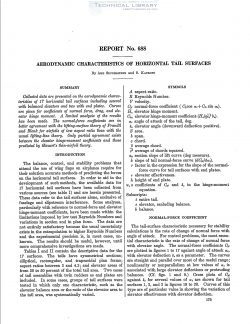naca-report-688

- Version
- 232 Downloads
- 1.29 MB File Size
- 1 File Count
- August 30, 2016 Create Date
- August 30, 2016 Last Updated
National Advisory Committee for Aeronautics, Report - Aerodynamic Characteristics of Horizontal Tail Surfaces

Collected data are presented on the aerodynamic charac—
teristics of 1’7 horizontal tail surfaces including several
with balanced elevators and two with end plates. Curves
are given for coefficients of normal force, drag, and ele—
vator hinge moment. A limited analysis of the results
has been made. The normal-force coefi‘icients are in
better agreement with the lifting-surface theory of Prandtl
and Blenk for airfoils of low aspect ratio than with the
usual lifting-line theory. Only partial agreement exists
between the elevator hinge—moment coeflicients and those
predicted by G'lauert’s thin-airfoil theory.
The balance, control, and stability problems that
attend the use of wing flaps on airplanes require for
their solution accurate methods of predicting the forces
on the horizontal tail surfaces. In order to aid in the
development of such methods, the available data for
17 horizontal tail surfaces have been collected from
various sources (see table I) and are herein presented.
These data refer to the tail surfaces alone, exclusive of
fuselage and slipstream interference. Some analyses,
particularly with reference to normal-force and elevator
hinge-moment coefficients, have been made within the
limitations imposed by low test Reynolds Numbers and
variations in section and in plan form. The data are
not entirely satisfactory because the usual uncertainty
exists in the extrapolation to higher Reynolds Numbers
and the experimental precision is, in most cases, un—
known. The results should be useful, however, until
more comprehensive investigations are made.
Tables I and II contain the descriptive data for the
17 surfaces. The tails have symmetrical sections;
elliptical, rectangular, and trapezoidal plan forms;
aspect ratios between 3 and 4.3; and elevator areas of
from 30 to 50 percent of the total tail area. Two cases
of tail assemblies with twin rudders as end plates are
included. In some cases, groups of tail surfaces were
tested in which only one characteristic, such as the
elevator balance area or the ratio of the elevator area to
the tail area, was systematically varied.
| File | Action |
|---|---|
| naca-report-688 Aerodynamic Characteristics of Horizontal Tail Surfaces.pdf | Download |
Comment On This Post